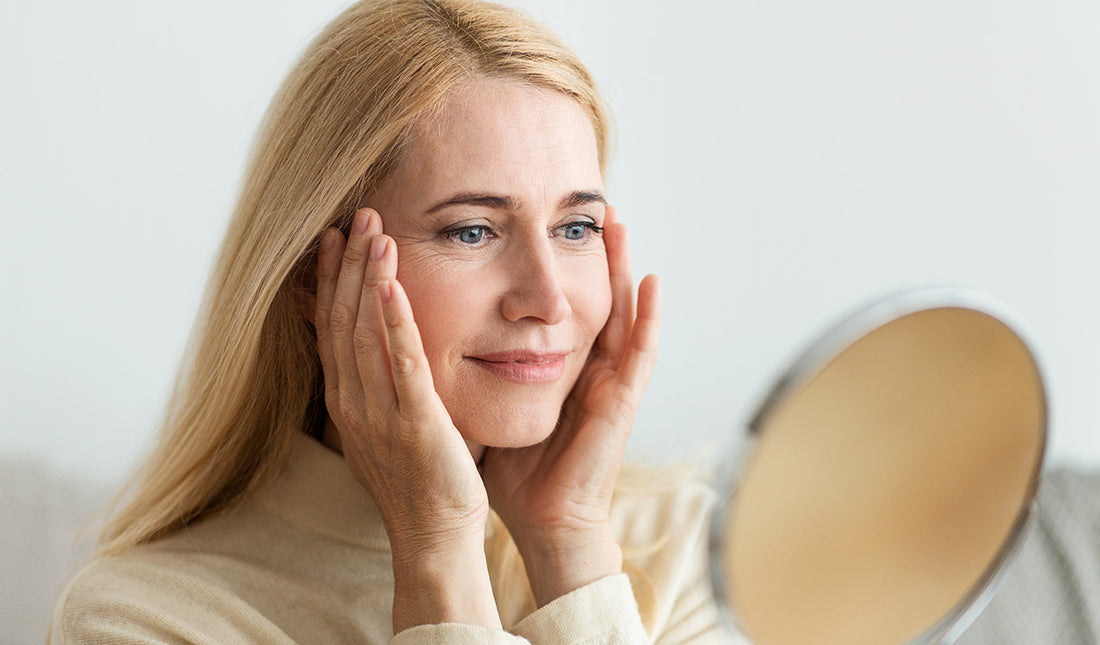
The ingredients list series | 3 min read
Resveratrol unveiled: part i - skincare hype or hero?

The Ingredients List series
Our Ingredients List series is way more than just a list of ingredients. It’s a set of articles that’ll dive into every active and filler used in skincare – whether you find them in Re-Dox or not – so you can better understand how, when and why they work, see through the myths about them, and create a routine that is effective for you.
TL;DR
If there were an award for a skincare ingredient that comes closest to being the “miracle drug for anti-ageing", Resveratrol would undoubtedly win. It is so much more than just an antioxidant – Resveratrol has a unique ability to trigger DNA repair in cells that have accumulated DNA damage with age. Quality DNA is the cornerstone of optimal cell function, which is the closest we may get to ‘anti-ageing’.
 BECOME A STOCKIST: Trans-Resveratrol and Glutathione boosted in our 15% Vitamin C Day Serum for the prevention of pre-mature ageing.
BECOME A STOCKIST: Trans-Resveratrol and Glutathione boosted in our 15% Vitamin C Day Serum for the prevention of pre-mature ageing.
A Little Bit of History...
Resveratrol is a naturally occurring antioxidant polyphenol first identified by the Japanese scientist, Michio Takaoka, who made this discovery in the roots of the flowery plant, Veratrum grandiflorum, collected from the Hokkadio Island.

Veratrum grandiflorum is a major source of resveratrol. (https://www.inaturalist.org/photos/33117973)
Takaoka published his findings in 1939; however, the article was hidden in the Japanese scientific crypts, so resveratrol was forgotten - until 2003, when David Sinclair, a junior scientist at the time, discovered that resveratrol could extend the lifespan of various organisms, including small rodents, by up to 30%!"

Fact: Although resveratrol is also found in red wine, we would need to consume 40 litres of red wine to obtain a standard 500 mg dose!
How does it work?
To understand how resveratrol works as an anti-ageing ingredient, we need to first understand this major principle:
- Ageing is quite literally the decline in cell function, which is caused by damage to one’s DNA.
What does this mean?
In other words, DNA damage is a major cause of ageing, and the real fountain of youth is repairing DNA that has been previously damaged.

How does DNA damage affect the ageing of skin? It affects the performance of a particular cell type in the skin called dermal fibroblasts.
Dermal fibroblasts – What are they?
Dermal fibroblasts – are the major cell type responsible for maintaining the skin structure. They are found in abundance within various layers of the skin, and they are responsible for making and degrading collagen, elastin, hyaluronic acid and all the other skin ‘goodies’ we are familiar with.

Dermal fibroblasts maintain a delicate balance of both making new collagen and degrading old collagen in the skin.
What happens to dermal fibroblasts as we age and accumulate DNA damage?
Age is more than just a number. In our youth, our skin contains young fibroblasts that are thin and slender. These cells move rapidly around our skin and produce collagen. Much like our energy levels, as we age, these once-speedy fibroblasts move around more sluggishly in our skin. The change in their appearance also is drastic. They change from a thin and slender appearance to a short and fat one.

Youthful dermal fibroblasts appear slender and are numerous (left), while aged dermal fibroblasts are more rounded and are less numerous (right). Blue arrows point to dermal fibroblasts. https://www.asbmb.org/asbmb-today/science/012923/old-cells-turn-back-the-clock; N. schmid et al / Scientific Reports 2019
This means that aged skin not only contains fewer dermal fibroblasts, but those aged fibroblasts make less collagen than they degrade and the collagen they do make is often ‘poor quality’ and disorganised. So, for the appearance of wrinkles on our skin, you can thank decreased fibroblast activity!
Thus, if we aim to reduce wrinkles, we need to tackle the source of the problem – we need to improve the function of fibroblasts as they age. This means we need to minimise DNA damage and repair DNA so aged fibroblast have the greatest potential to function youthfully.
 For Re-Dox blogs and offers, subscribe to our newsletter here.
For Re-Dox blogs and offers, subscribe to our newsletter here.
But it’s not all doom and gloom...Enter Resveratrol
This is where the potential of resveratrol shines as a naturally occurring antioxidant with the potential to tackle ageing at its very core.
The latest research shows that resveratrol activates a protein inside cells which is critical for DNA repair. This protein is called SIRT1 and it belongs to a wider family of sirtuin proteins.
When SIRT1 is activated, DNA repair is initiated and DNA damage that has occurred previously now has the opportunity to correct itself.
Optimal cell function (dermal fibroblasts) can now occur, and this is critically important when it comes to the appearance of ageing in the skin.
More than just an antioxidant
It is important to understand how resveratrol activates SIRT1 and DNA repair in cells – and, believe it or not, it has very little to do with the fact that it is an antioxidant.
If it were merely due to it being an antioxidant, we would have also observed similar anti-ageing effects with much stronger antioxidants including vitamin e (tocopherol), astaxanthin and even quercetin. However, we only truly observe anti-ageing effects in terms of DNA repair mechanism in resveratrol, and this suggests that resveratrol acts in a unique way.
But, wait! Before you race to get your hands on resveratrol*, there is so much more to learn.
Stay tuned for Part II of this article where we discuss the most ideal form of resveratrol for DNA repair, the best route for taking resveratrol for optimal skin health and reveal the researched optimal dose of resveratrol.
*Re-Dox offers stablised trans-resveratrol boosted in the Nourishing Phenolic Day Serum for fight against pre-mature ageing.
